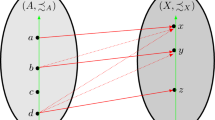Abstract
Cooperation is doubtless a relevant ingredient on rewriting rules based computing models. This paper provides an overview on both classical and newest results studying how cooperation among objects influences the ability of cell-like membrane systems to solve computationally hard problems in an efficient way. In this paper, two types of such membrane systems will be considered: (a) polarizationless P systems with active membranes without dissolution rules when minimal cooperation is permitted in object evolution rules; and (b) cell-like P systems with symport/antiport rules of minimal length. Specifically, assuming that P is not equal to NP, several frontiers of the efficiency are obtained in these two computing frameworks, in such manner that each borderline provides a tool to tackle the P versus NP problem.

Similar content being viewed by others
References
Alhazov A, Pérez-Jiménez MJ. Uniform solution of QSAT using polarizationless active membranes. In Durand-Lose J, Margenstern M, editors. Machines, computations, and universality. Lecture notes in computer science, vol. 4664; 2007. pp. 122–33.
Pavel AB, Buiu C. Using enzymatic numerical P systems for modeling mobile robot controllers. Nat Comput. 2012;11(3):387–93.
Celiker H, Gore J. Cellular cooperation: insights from microbes. Trends Cell Biol Trends Cell Biol. 2013;23(1):9–15.
Freund R, Păun Gh. On the number of non-terminal symbols in graph-controlled, programmed and matrix grammars. In Margenstern M, Rogozhin Y, editors. Machines, computations, and universality, international conference on machines, computations, and universality. Berlin, Heidelberg: Springer; 2001. pp. 214–25.
Frisco P, Gheorghe M, Pérez-Jiménez MJ. Applications of membrane computing in systems and synthetic biology. Complexity and computation series: emergence. 2014.
García-Quismondo M, Graciani C, Riscos-Núñez A. Membrane computing as a modelling tool: looking back and forward from Sevilla. In Graciani C, Riscos-Núñez A, Păun Gh, Rozenberg Gr, Salomaa A, editors. Enjoying natural computing: essays dedicated to Mario de Jesús Pérez-Jiménez on the occasion of his 70th birthday. Springer International Publishing; 2018. pp. 114-29.
Garey MR, Johnson DS. Computers and intractability a guide to the theory of NP-completeness. Freeman and Company; 1979.
Gutiérrez-Naranjo MA, Pérez-Jiménez MJ, Riscos-Núñez A, Romero-Campero FJ. On the power of dissolution in P systems with active membranes. In Freund R, Păun Gh, Rozenberg Gr, Salomaa A, editors. Membrane computing, 6th international workshop, WMC 2005, Vienna, Austria, July 18–21, 2005. Revised Selected and Invited Papers. Lecture notes in computer science, vol. 3850; 2006. pp. 224–40.
Leporati A, Ferretti C, Mauri G, Pérez-Jiménez MJ, Zandron C. Complexity aspects of polarizationless membrane systems. Nat Comput. 2009;8(4):703–17.
Macías-Ramos LF, Song B, Valencia-Cabrera L, Pan L, Pérez-Jiménez MJ. Membrane fission: a computational complexity perspective. Complexity. 2016;21(6):321–34.
Papadimitriou CH. Computational complexity. Boston: Addison-Wesley Publishing Company; 1994.
Pan L, Păun Gh, Pérez-Jiménez MJ, Song T. Bio-inspired Computing: theories and applications. Communications in computer and information science series; 2014.
Păun A, Păun Gh. The power of communication: P systems with symport/antiport. N Gener Comput. 2002;20(3):295–305.
Păun Gh, Rozenberg G, Salomaa A. The Oxford handbook of membrane computing. Oxford: Oxford University Press; 2009.
Păun Gh. Computing with membranes. J Comput Syst Sci. 2000;61(1):108–43.
Păun Gh. Languages in membrane computing: some details for spiking neural P systems. In: Ibarra OH, Dang Z, editors. Developments in language theory. Berlin, Heidelberg: Springer; 2006. p. 20–35.
Păun Gh. Membrane computing: an introduction. New York: Springer Natural Computing Series; 2002.
Păun Gh. P systems with active membranes: attacking NP-complete problems. J Autom Lang Comb. 2001;6:75–90.
Pérez-Jiménez MJ, Romero-Jiménez Á, Sancho-Caparrini F. Complexity classes in models of cellular computing with membranes. Nat Comput. 2003;2(3):265–85. https://doi.org/10.1023/A:1025449224520.
Song B, Pérez-Jiménez MJ, Pan L. Efficient solutions to hard computational problems by P systems with symport/antiport rules and membrane division. Biosystems. 2015;130:51–8.
Valencia-Cabrera L, Orellana-Martín D, Martínez-del-Amor MA, Pérez-Jiménez MJ, Riscos-Núñez A. Computational efficiency of minimal cooperation and distribution in polarizationless P systems with active membranes. Fundam Inf. 2017;153(1–2):147–72.
Valencia-Cabrera L, Orellana-Martín D, Martínez-del-Amor MA, Pérez-Jiménez MJ, Riscos-Núñez A. Polarizationless P systems with active membranes: Computational complexity aspects. J Autom Lang Comb. 2016;21(1–2):107–23.
Valencia-Cabrera L, Orellana-Martín D, Riscos-Núñez A, Pérez-Jiménez MJ. Counting membrane systems. In: Proceedings of the Eighteenth International Conference on Membrane Computing (CMC18), July 24–28, 2017. Bradford; 2017. pp. 359–72.
Valencia-Cabrera L, Orellana-Martín D, Riscos-Núñez A, Pérez-Jiménez MJ. Minimal cooperation in polarizationless P systems with active membranes. In Graciani C, Păun Gh, Orellana-Martín D, Riscos-Núñez A, Valencia-Cabrera L, editors. Proceedings of the Fourteenth Brainstorming Week on Membrane Computing, 1-5 February, 2016. Sevilla; 2016. pp. 327–56.
Valencia-Cabrera L, Orellana-Martín D, Riscos-Núñez A, Pérez-Jiménez MJ. Reaching efficiency through complicity in membrane systems: dissolution, polarization and cooperation. Theor Comput Sci. 2017;701:226–34.
Valencia-Cabrera L, Song B, Macías-Ramos LF, Pan L, Riscos-Núñez A, Pérez-Jiménez MJ. Minimal cooperation in P systems with symport/antiport: a complexity approach. In Macías LF, Păun Gh, Riscos A, Valencia L, editors. Proceedings of the Thirteenth Brainstorming Week on Membrane Computing, 2–6 February, 2015. Sevilla; 2015. pp. 301–23.
Wang T, Zhang GX, Pérez-Jiménez MJ. Fuzzy membrane computing: theory and applications. Int J Comput Commun Control. 2015;10(6):904–35.
Zandron C, Ferretti C, Mauri G. Solving NPcomplete problems using P systems with active membranes. In: Antoniou I, Calude CS, Dinneen MJ, editors. Unconventional models of computation. Heidelberg: Springer; 2000. p. 289–301.
Zhang G, Pérez-Jiménez MJ, Gheorghe M. Real-life applications with Membrane Computing. Complexity and computation series: emergence; 2017.
Acknowledgements
This work is supported by the research project TIN2017-89842-P, cofinanced by Ministerio de Economía, Industria y Competitividad (MINECO) of Spain, through the Agencia Estatal de Investigación (AEI), and by Fondo Europeo de Desarrollo Regional (FEDER) of the European Union. The authors also acknowledge the Grants No 61320106005 of the National Natural Science Foundation of China.
Author information
Authors and Affiliations
Corresponding author
Rights and permissions
About this article
Cite this article
Orellana-Martín, D., Valencia-Cabrera, L., Riscos-Núñez, A. et al. Minimal cooperation as a way to achieve the efficiency in cell-like membrane systems. J Membr Comput 1, 85–92 (2019). https://doi.org/10.1007/s41965-018-00004-9
Received:
Accepted:
Published:
Issue Date:
DOI: https://doi.org/10.1007/s41965-018-00004-9




